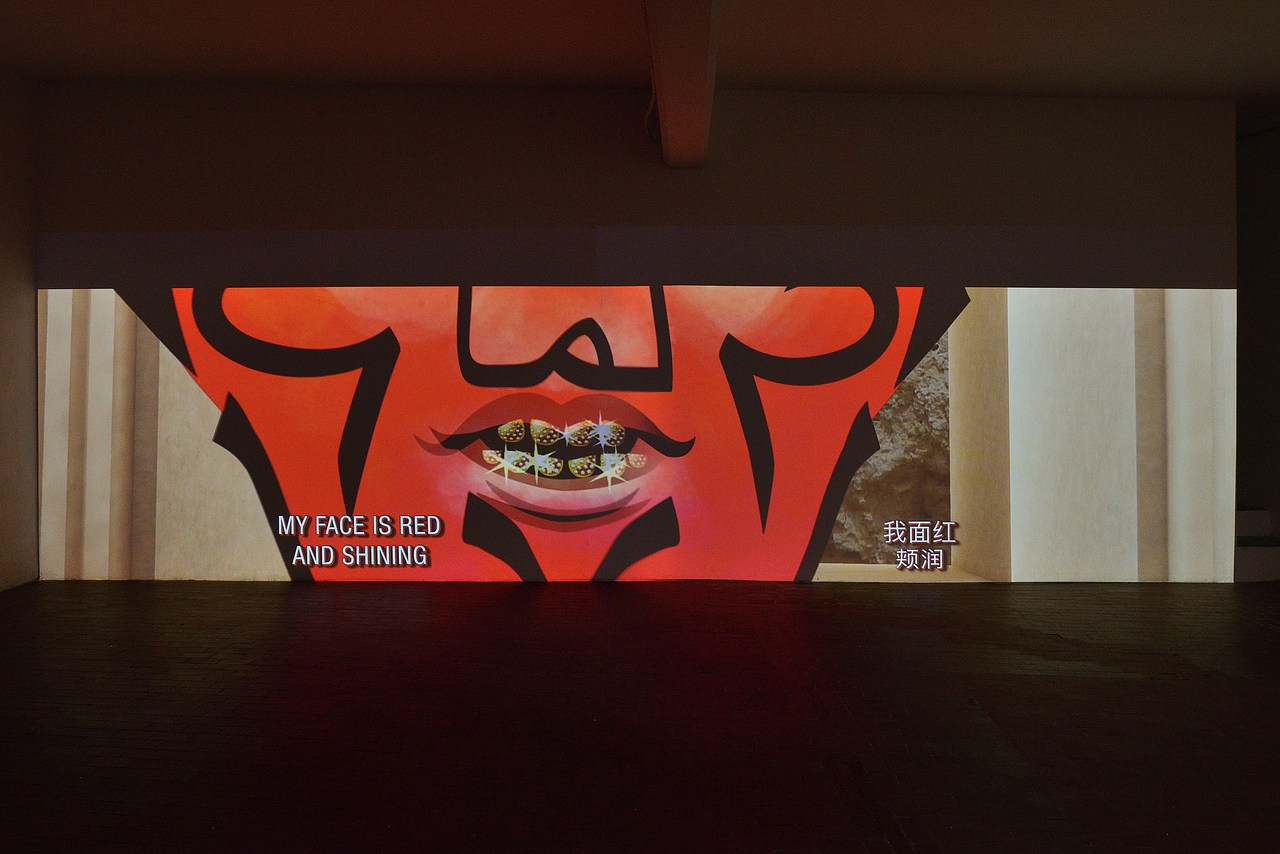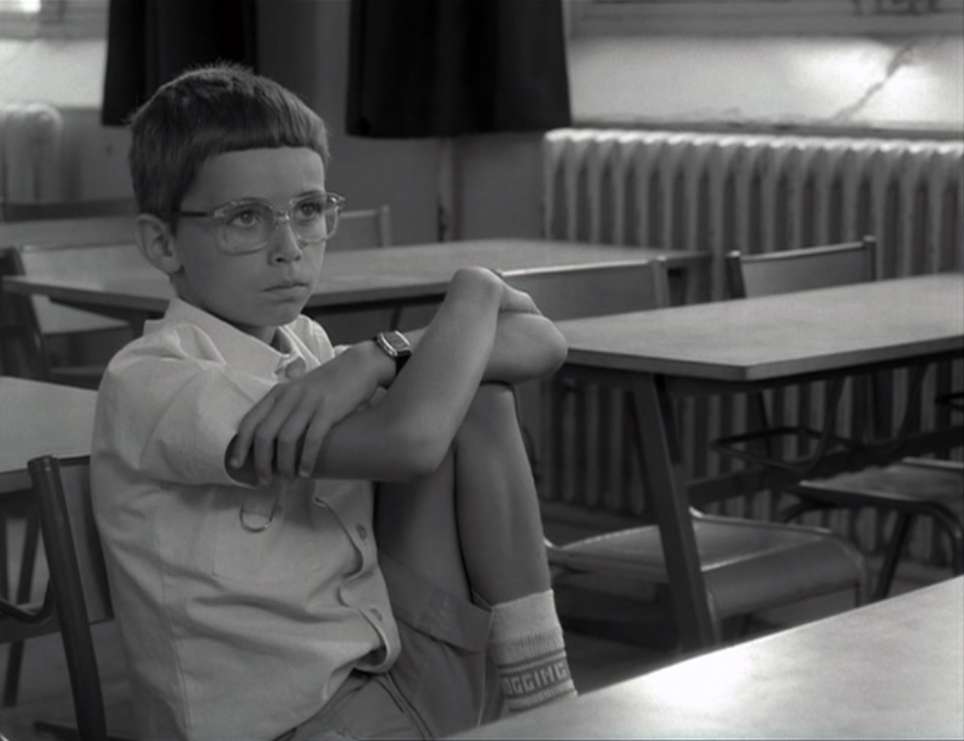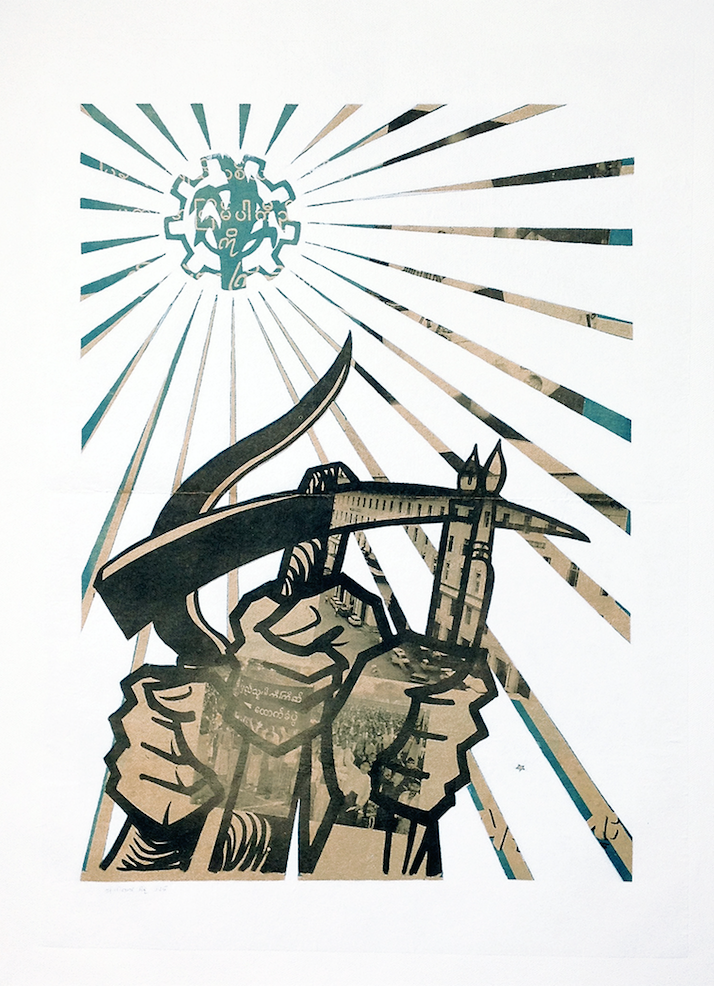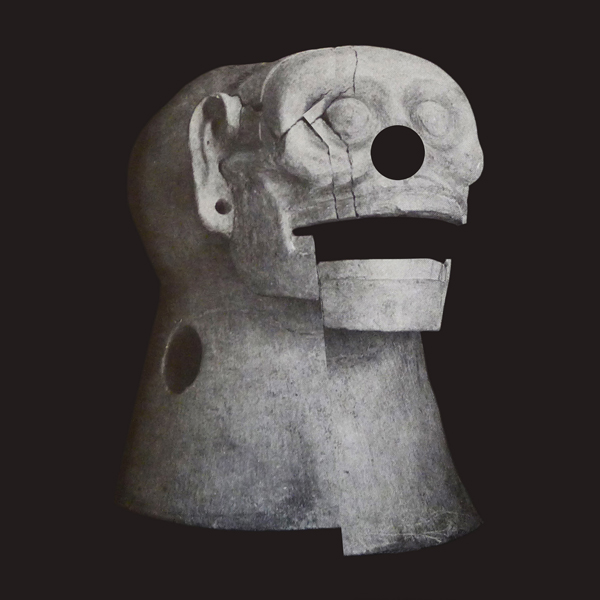
© » KADIST
The Propeller Group and Superflex
Fade In (the whole title of the film is actually the entire five page script) is a collaboration with the Danish artist collective Superflex (group of freelance artist–designer–activists committed to social and economic change, founded in 1993 by Jakob Fenger, Rasmus Nielsen and Bjørnstjerne Christiansen). There are several time layers to understand the story behind this film. In 1601, the San Jago set sail from Goa for Lisbon; the cargo included the first consignment of South East Asian porcelain destined for the European market.

© » KADIST
The Atlas Group
This image is an extract from a notebook in the archives of doctor Fakhouri that lists the cars that have been used for bombs between 1975 and 1991. Each page of the notebook contains a collage of an image of a car with the same make, model and color as the exploded car with a text in Arabic that gives the details of the place, time and date of the explosion, the number of people in the accident, the perimeter of destruction, the weight and the type of explosive. The images of the cars made visible are only equivalents since the cars that actually exploded are totally destroyed.

© » KADIST
The Atlas Group
It is a little known fact that Lebanese historians were also gamblers during the war. They met every Sunday at the race courses. Race after race, the historians were positioned behind the press photographers who were there to take a picture of the winning horse passing the finishing line.
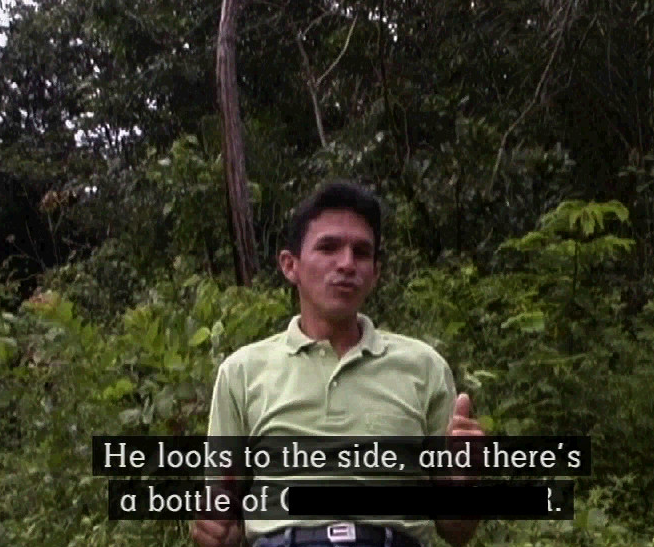
© » KADIST
SUPERFLEX
SUPERFLEX makes a distinction between two types of projects with different temporalities: works that occur during an exhibition and other that evolved over several years. Thus, since 1997, they are working on a biogas system (SUPERGAS), first installed in Kenya, then Thailand and today in Mexico, perfecting at each stage the means of production, utilization and commercialization of this system. GUARANA POWER is one of these sustainable projects that create a real economy.

© » KADIST
Yangjiang Group
Drawing & Print (Drawing & Print)
One Day in the Mountain is a bilingual calligraphic performance piece written in ink superimposed with food leftover from a meal. The eponymous text: “One day in mountain is worth two thousands years in the world.” is written horizontally from left to right in both English and Chinese, following the writing order of modern Chinese instead of the traditional vertical right to left. With the word “is” migrating from the middle of the English phrase to be surrounded by Chinese characters, the resultant text appears to be spatially illustrating the meaning of being isolated in the mountain.

© » KADIST
Che Onejoon
For the last few years, Che Onejoon has been focusing on the relationships between African countries and North Korea. He has attempted to interpret the ongoing Cold War in the Korean peninsula from a new geopolitical perspective. His resulting body of work focuses on the memorial monuments, statues and architectures that were built in 13 different African countries by North Korean government.

© » KADIST
Thea Djordjadze
The sculpture And Shadows Will Follow is an angle piece that articulates a space since its appearance highly changes depending on the point of view. Initially conceived for an exhibition with natural light, this work diffracts light and projects a shadow like a cut-out. Surprisingly the work stands like a drawing in space, a graph and its imprint, a line and a point.

© » KADIST
Thu Van Tran
From Green to Orange is a series of silver films immersed in a bath of dye and rust. While the perception of the subject is made difficult by the chemical reaction, vegetation becomes discernible at a closer look. Thu Van Tran interferes in the depths of a mystery, in the density of a hallucinated dream.

© » KADIST
Bakudapan Food Study Group
Mooi indie (which translates to “Beautiful Indies”) is a term used to depict the beauty of nature in the East Indies during the period of Dutch colonialism in Indonesia. The term is usually used to describe a painting, romanticising the alluring tropics through the lens of European imperialism. Later in the 1950s, the prominent Indonesian painter S. Sudjojono, who is known as one of the founding fathers of Indonesian Modern Art, publicly rejected the Mooi Indie genre as Indonesian art.

© » KADIST
Che Onejoon
Che Onejoon’s unsettling video My Utopia opens with a round table of women asking and answering the questions “Who am I? Where did I come from? Where should I go?” One of the women featured is Monique Macías, the daughter of Francisco Macías Nguema, the first Prime Minister of Equatorial Guinea.

© » KADIST
Gabriella and Silvana Mangano
There is no there by Gabriella and Silvana Mangano is a black and white looped video with sound, in conjunction with a live performance. The work is inspired by the Blue Blouse, a political propaganda theater movement which spread across the Soviet Union in the mid-1920s. More specifically, the work takes the form of ‘Living Newspapers’, which were performances based on topical news events.

© » KADIST
Slavs and Tatars
Wheat Mollah ( 2011) is one of Slavs and Tatars composite object. The title Wheat Mollah has various interpretations, from “master” or spiritual authority for Shiites and “friend” for Sunnis. The turban is also worn in a diversity of cultures and religions in Africa, Asia and India.

© » KADIST
Michelle and Noel Keserwany
Les Chenilles by Michelle and Noël Keserwany is a sensual film that translates the source of women’s oppression into the means for their liberation. In this narrative film, protagonists Asma and Sarah meet while working as waitresses in France. They both come from the Levant and, each in their own way, carry burdens of the past and the consequences of colonialism.
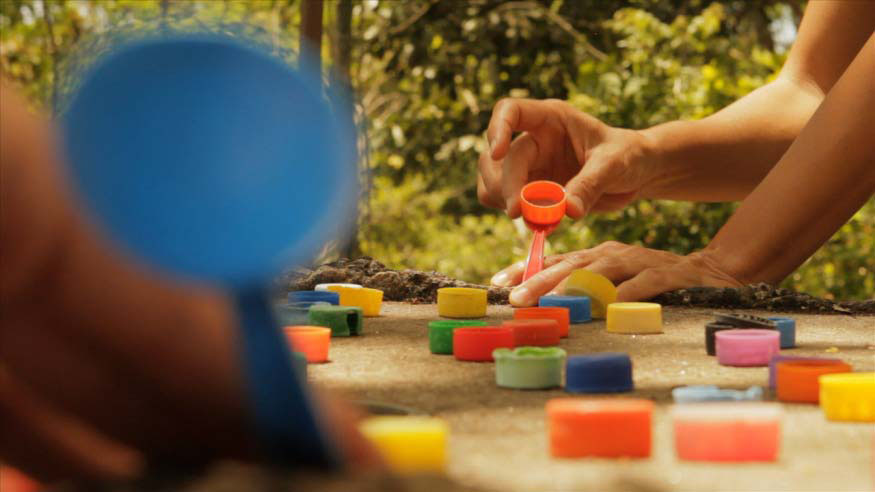
© » KADIST
Donna Conlon and Jonathan Harker
In Tapitapultas (2012), Donna Conlon and Jonathan Harker comment on mass consumerism and pollution by way of a game they invented. The artists used disposable spoons as catapults to shoot thousands of plastic bottle caps at a hole in a concrete platform. The platform was once part of a U. S. military installation in the Panama Canal Zone, and it is now an observation deck in a nature park.

© » KADIST
Köken Ergun and Tashi Lama
Nepal and China signed an agreement for the Belt and Road Initiative (BRI) in 2017. The BRI is a strategy that was set forth by China in 2013 to expand its influence by building a network of economic corridors around the globe. BRI projects in Nepal include the Kathmandu-Kerung Railway, the Galchhi-Rasuwagadhi-Kerung 400 kilovolt transmission line, the 762 megawatt Tamor hydroelectric dam, and the 426 megawatt Phukot Karnali run-of-the-river hydropower project.

© » KADIST
Jay Chung and Takeki Maeda
Jay Chung and Q Takeki Maeda remake a clip from the 1970s they found on the internet, and without really changing this archive material, displace it by imitating the staging and the acting with scrupulous precision. The slightest details are reproduced identically with great minutiae. The facial expressions are absurd, the prim attitude makes no sense.

© » KADIST
Pooja Gurung and Bibhusan Basnet
DADYAA: The Woodpeckers of Rotha by Pooja Gurung and Bibhusan Basnet illuminates a unique and seldom seen international perspective on indigenous cultures and contemporary social issues in the Nepali context. A small masterpiece, the work engages with one of the most pressing social issues in Nepal, mass migration and the dissolving of social fabric in rural areas. The story begins with an old couple, Atimaley and Devi, who live in a village in Jumla, in the highlands of Western Nepal.

© » KADIST
Musquiqui Chihying and Gregor Kasper
Addressing the legacy of colonialism, The Guestbook by Musquiqui Chihying and Gregor Kasper is a slow-paced, black-and-white film exploring the German colony of Togoland, now the Republic of Togo. The guestbook in question—a thin, battered copy that Do Do, the Togolese protagonist of the film, finds in Berlin’s State Library—is filled with the signatures of colonial-era explorers. The plot follows Do Do as he seeks out Treptower Park, where the JAZZ musician Kwassi Bruce was once exhibited in a human zoo in the first German Colonial Exhibition.

© » KADIST
Jonas Van and Juno B
Jonas Van and Juno B’s video work Kebranto is anchored by the figure of Boitatá, a snake that is part of the imaginary Guaraní communities that live between the current nation-states of Argentina, Brazil, Paraguay, and Uruguay. The mythical figure Boitatá is a protector of jungles and forests. In GuaraníBoitatá is the union of two words: Mbói (snake) and tatá (fire).

© » KADIST
Köken Ergun and Satyam Mishra
Nepal and China signed an agreement for the Belt and Road Initiative (BRI) in 2017. The BRI is a strategy that was set forth by China in 2013 to expand its influence by building a network of economic corridors around the globe. BRI projects in Nepal include the Kathmandu-Kerung Railway, the Galchhi-Rasuwagadhi-Kerung 400 kilovolt transmission line, the 762 megawatt Tamor hydroelectric dam, and the 426 megawatt Phukot Karnali run-of-the-river hydropower project.

© » KADIST
Angela Detanico and Rafael Lain
Letters of the Greek alphabet glisten on a black background. When a letter appears, there is a sound. Each letter corresponds to a star in the sky.

© » KADIST
Raimond Chaves and Mantilla Gilda
Many of Chaves and Gilda’s works use recycled cardboard. For Partituras, they arranged stacks of cardboard into long rectangles on the ground, which are visually analogous to fields of graphite in Chaves’s pencil drawings. While the blocks have a spare presence in space, they exist more full solidity within their borders, and the recycled nature of the cardboard adds some play into the clean minimalist rectangles and cubes.

© » KADIST
Chantal Edie and Zacharie Ngnogue
Au non de la liberté (Tiko drink Kumba drunk) is a photographic series by Zacharie Ngnogue and Chantal Edie that considers the correlation between those who hold power in Cameroon and how their actions affect the populations they rule in often compromising ways. “Tiko drink-Kumba drunk” is an adage that is commonly used in the Southwest province of Cameroon to speak of how one’s actions affect others. Civil liberties are next to non-existent in Cameroon, the law is lawless, and structured in a way that is intended to attack its citizens’ human rights.

© » KADIST
Chantal Edie and Zacharie Ngnogue
Au non de la liberté (Tiko drink Kumba drunk) is a photographic series by Zacharie Ngnogue and Chantal Edie that considers the correlation between those who hold power in Cameroon and how their actions affect the populations they rule in often compromising ways. “Tiko drink-Kumba drunk” is an adage that is commonly used in the Southwest province of Cameroon to speak of how one’s actions affect others. Civil liberties are next to non-existent in Cameroon, the law is lawless, and structured in a way that is intended to attack its citizens’ human rights.

© » KADIST
Ana Vaz
Há Terra! (There Is Land!) is a short film by Ana Vaz that picks up on the artist’s previous film A Idade da Pedra (2013), in which Vaz imagined premodernity in her native Brazil.

© » KADIST
Ha Tae-Bum
Ha Tae-Bum’s “White” series, started in 2008, begins with photographic images from the mainstream media depicting sites of conflict or crisis. The artist eliminates human presence, miscellaneous details, and all color from the images, then “rebuilds” them into quiet, achromatic models with thin white paper. Once complete, the models are photographed in a nearly identical composition as the original image.

© » KADIST
Nguyen Trinh Thi
Landscape Series no. 1 presents landscape as a “quiet witness of history.” It began with searches of online archives of Vietnamese news-media, for images of figures in landscapes “pointing, to indicate a past event, the location of something gone, something lost or missing.” The uniformity is striking but the sequence is subtly structured: the typology hints at narrative progression, though of an uninformative narrative, lacking details.

© » KADIST
Nguyen Trinh Thi
The essay film How to Improve the World by Nguyen Trinh Thi takes us into an indigenous village of the Jrai people in the Central Highlands of Vietnam, in Gia Lai province. It begins with sound – perhaps a hammer, or a gong – the lack of image making its identification difficult. A landscape emerges of an open field where a farmer tends his grazing cow herd.

© » KADIST
He Xiangyu
He Xiangyu’s Terminal 3 presents excerpts from the lives of young African acrobats attending the Hebei Wuqiao Acrobatic Arts School in China. Acrobatics, which had a rich history as a court display in imperial China, is now integral to the cultural industries and tourism sector in Wuqiao, continuing a legacy of expending bodies for monetary gain. From 2016 to 2019, He intermittently went to Wuqiao Acrobatics School in Hebei Province to record the daily lives of the students who study a variety of acrobatic skills during their year-long program.

© » KADIST
Lenka Clayton and Phillip Andrew Lewis
Five Hundred Twenty-Four, a single-channel video installation by Lenka Clayton and Phillip Andrew Lewis, features singers from over twenty Cleveland-area choirs counting numbers in an iterative process: one person sings “one”, then two people sing “two”, and so forth, to 524. Each choir was filmed separately, and the artists weave together the audio while the video features each choir individually. The juxtaposition of different contexts in which singing occurs functions as an embedded sociological study of various communities throughout the region.
Chantal Edie and Zacharie Ngnogue
Chantal Edie and Zacharie Ngnogue are a photography duo who channel their personal experiences into social commentaries...
An-My LE
- location: New York, New York
- year born: 1960
- gender: female
- home town: Saigon, Vietnam
Ana Vaz
Ana Vaz is an artist and filmmaker whose works speculate on the relationships between self and other, and myth and history, through a cosmology of signs, references, and perspectives...
Nguyen Trinh Thi
Nguyen Trinh Thi is a moving image pioneer, not only within the landscape of contemporary art in Vietnam, but also broader South East Asia...
Mary Ann Aitken
Mary Ann Aitken was known to be very private about her art practice; she was considered somewhat of an outsider by her peers affiliated with the second wave of Detroit’s Cass Corridor arts movement...
The Atlas Group
The Atlas Group is a research and artistic project founded by Lebanese artist Walid Raad in 1999...
Slavs and Tatars
Self-described as an “Eurasian-based” collective, Slavs and Tatars investigates the “polemics and intimacies” of the region “east of the former Berlin Wall and west of the Great Wall of China” or Caucasia...
John Wood and Paul Harrison
John Wood and Paul Harrison have been working collaboratively since 1993, producing single screen and installation-based video works...
Leung Chi Wo and Wong Sara
Leung Chi Wo tends to highlight in his art the boundaries between viewing and voyeurism, real and fictional, and art and the everyday...
Ho Rui An
The artist, writer, and researcher Ho Rui An probes histories of globalization and governance, performing a detournement of dominant semiotic systems across text, film, installation, and lecture...
Che Onejoon
Che Onejoon started working with photography in mandatory military service as an evidence photographer for the South Korean Combat Police recording different incidents for proof...
Ad Minoliti
Ad Minoliti is a painter who combines the pictorial language of geometric abstraction with the perspective of queer theory...
Yangjiang Group
Zheng Guogu founded the artistic group Yangjiang Group in 2002 with Chen Zaiyan (b...
Etel Adnan and Lynn Marie Kirby
Visual artist, poet, and essayist Etel Adnan writes what must be communicated through language, and paints what cannot...
Bakudapan Food Study Group
Bakudapan Food Study Group is a study group that discusses ideas about food...
Donna Conlon and Jonathan Harker
- location: Panama City, Panama
- year born: 1966
- nationality: American and Ecuadorian
Jordan Ann Craig
Jordan Ann Craig is a Northern Cheyenne artist born and raised in the Bay Area; she invests her work with a strong interest in Indigenous culture and the history of its destruction by settlers...
Maayan Amir and Ruti Sela
Maayan Amir and Ruti Sela, two young Israeli women artists work collaboratively or individually by project...
Michelle and Noel Keserwany
Michelle and Noël Keserwany compose and perform their own songs, as well as contribute to the illustrations and animations featured in the videos they produced...
Lenka Clayton and Phillip Andrew Lewis
Lenka Clayton and Phillip Andrew Lewis’s collaborative practice is social at its core: it engages with and connects communities outside of the so-called art world in both production and presentation...
Pooja Gurung and Bibhusan Basnet
Pooja Gurung and Bibhusan Basnet have a joint practice that merges film and visual art...
Ha Tae-Bum
Ha Tae-Bum (b...
Gabriella and Silvana Mangano
Gabriella Mangano and Silvana Mangano are an artistic duo and identical twins known for their collaborative and performative video practice...
Olive Martin and Patrick Bernier
Patrick Bernier and Olive Martin are a duo of artists collaborating since 1999...
Jane Jin Kaisen and Guston Sondin-Kung
Working with narrative experimental film, multi-channel video installation, performative video art, photography, and text, Jane Jin Kaisen engages themes of memory, trauma, migration and translation at the intersection of personal and collective histories...
Musquiqui Chihying and Gregor Kasper
Through his artistic career, Musquiqui Chihying has striven to dislocate and reconstruct established modes of behavior within systems and structures of power...
The Propeller Group and Superflex
The Propeller Group was established in 2006 as a cross-disciplinary structure...
Raimond Chaves and Mantilla Gilda
The collaborative works of Raimond Chaves and Mantilla Gilda often derive from a direct engagement with the world...
Thu Van Tran
Thu Van Tran grew up in the paradox of the dismantlement of the French colonial empire in Vietnam...
Christine Sun Kim and Thomas Mader
Christine Sun Kim and Thomas Mader have been collaborating for the last 5 years, covering communication in a variety of formats such as recording an overnight shipment from Berlin to New York ( Recording Contract , 2013), compiling 24 hours of invited contributors’ studio time ( Busy Day , 2014), and using the arm game, a combination of body and face, in order to describe a series awkward situations ( Classified Digits , 2016)....

© » APERTURE
about 5 months ago (12/01/2023)
For the past two decades, An-My Lê has used photography to examine her personal history and the legacies of US military power, probing the tension between experience and storytelling....
-
1980-1989
Jean-Marie Straub and Danièle Huillet
1982En rachâchant is based on the short story Ah! Ernesto! (1971) by Marguerite Duras in which the child Ernesto does not want to go to school anymore as all that he is taught are things he does not know...
-
1990-1999
The Atlas Group
1991This image is an extract from a notebook in the archives of doctor Fakhouri that lists the cars that have been used for bombs between 1975 and 1991...
The Atlas Group
1996It is a little known fact that Lebanese historians were also gamblers during the war...
John Wood and Paul Harrison
1996One of John Wood and Paul Harrison’s earliest works, Device features Harrison performing a series of actions, assisted by the titular ‘devices’, that use physics to force his body into unusual and uncomfortable positions...
John Wood and Paul Harrison
19973-Legged is an early video work by John Wood and Paul Harrison in which they appear with their legs tied together (as one would do in a three-legged race)...
-
2000-2009
Mary Ann Aitken
2002Untitled (Boom Box, Double-Sided) by Mary Ann Aitken is representational painting of a boom box on an unconventionally long canvas painted on both sides, to mimic the scale and appearance of the actual appliance...
Maayan Amir and Ruti Sela
2003In Beyond Guilt the two artists create a portrait of our generation in three parts...
Jay Chung and Takeki Maeda
2009Jay Chung and Q Takeki Maeda remake a clip from the 1970s they found on the internet, and without really changing this archive material, displace it by imitating the staging and the acting with scrupulous precision...
Pauline Boudry and Renate Lorenz
2009Salomania sees choreographer and filmmaker Yvonne Rainer and artist Wu Tsang rehearse scenes from Valda’s Solo , a chapter of a film Rainer made in 1972 after having seen women perform the dance of the seven veils in Alla Nazimova’s 1923 silent film Salomé ...
Mary Ann Aitken
2009Untitled (Diptych) by Mary Ann Aitken is a pair of paintings; one entirely abstract and the other a hybrid of representational and abstract elements...
-
2010-2019
The Propeller Group and Superflex
2010Fade In (the whole title of the film is actually the entire five page script) is a collaboration with the Danish artist collective Superflex (group of freelance artist–designer–activists committed to social and economic change, founded in 1993 by Jakob Fenger, Rasmus Nielsen and Bjørnstjerne Christiansen)...
Thea Djordjadze
2010The sculpture And Shadows Will Follow is an angle piece that articulates a space since its appearance highly changes depending on the point of view...
Ha Tae-Bum
2010Ha Tae-Bum’s “White” series, started in 2008, begins with photographic images from the mainstream media depicting sites of conflict or crisis...
Jane Jin Kaisen and Guston Sondin-Kung
2010The Woman, The Orphan, and The Tiger begins with the sound of women’s voices describing histories of violence, of things repressed and silenced...
Leung Chi Wo and Wong Sara
2010Photojournalist with Two Cameras restages a portrait of a photojournalist from the background of an old photograph of protest published in South China Morning Post on January 10, 2010 under the headline “Return of the Radicals: Recent angry protests are nothing new.” The photojournalist in the photograph, probably from a protest of earlier decades, was capturing the scene of a protester’s arrest while wearing two cameras...
Olive Martin and Patrick Bernier
2010The Mohawk, the emblematic Frontier river in the period of American colonisation, is here a cable of data transmission, and the 7 Sultans Casino is a virtual destination, one of the three hundred online casinos hosted by the servers located in Kahnawake, a small native american indian reserve to the south of Montreal...
Leung Chi Wo and Wong Sara
2010Office Lady with a Red Umbrella restages a figure from a 1980 postcard made from a photograph from 1950’s...
Võ An Khánh
2010In Extra Curriculum Political Science Class 7/1972 , a group of women walk bare-foot and single file towards Dat Mui Mangrove in Ca Mau Province to attend ‘political science class’...
An-My LE
2010The print Patient Admission, US Naval Hospital Ship Mercy, Vietnam (2010) features an Asian Buddhist monk and an American Navy Solider on board the Mercy ship –one of the two dedicated hospital ships of the United States Navy– sitting upright in their chairs and adopting the same posture...
Ei Arakawa and Sergei Tcherepnin
2011Part of a series entitled “Looking at Listening”, 2011, the piece invited the spectator to experiment and consider sound as a kinetic and synesthetic process, where multiple experiences and senses can cross...
Tun Win Aung and Wah Nu
2011Tun Win Aung and Wah Nu initiated the series 1000 Pieces (of White) in 2009, as a way to produce objects and images as a portrait of their shared life as partners and collaborators...
Ana Teresa Fernández
Drawing & Print
2011(Drawing & Print) The artist writes about her work Borrando la Frontera, a performance done at Tijuana/San Diego border: “I visually erased the train rails that serve as a divider between the US and Mexico...
Yangjiang Group
Drawing & Print
2012(Drawing & Print) One Day in the Mountain is a bilingual calligraphic performance piece written in ink superimposed with food leftover from a meal...
Donna Conlon and Jonathan Harker
2012In Tapitapultas (2012), Donna Conlon and Jonathan Harker comment on mass consumerism and pollution by way of a game they invented...
Ana Roldán
2012Ana Roldán’s Primeval forms series looks up close at the fecund shapes of plants often found in the artist’s native Mexico...
Ana Roldán
2012Ana Roldán’s Displacements works use images taken from a 1970s exhibition catalogue for an exhibition called The Death in Mexico...
Che Onejoon
2013For the last few years, Che Onejoon has been focusing on the relationships between African countries and North Korea...
Thu Van Tran
2014From Green to Orange is a series of silver films immersed in a bath of dye and rust...
Gabriella and Silvana Mangano
2015There is no there by Gabriella and Silvana Mangano is a black and white looped video with sound, in conjunction with a live performance...
João Maria Gusmão and Pedro Paiva
2015The artist duo João Maria Gusmão and Pedro Paiva traveled to Japan for a month to make a series of short 16mm films, often shot in slow-motion...
Christine Sun Kim and Thomas Mader
2016Indexes that either allow or inhibit the establishment of communication exist in both signed as well as spoken languages...
Etel Adnan and Lynn Marie Kirby
Drawing & Print
2017(Drawing & Print) In conjunction with KADIST’s 2017 exhibition If Not Apollo, the Breeze , artist and filmmaker Lynn Marie Kirby performed Transmissions , a video and live reading created with longtime collaborator Etel Adnan...
Bakudapan Food Study Group
2018Mooi indie (which translates to “Beautiful Indies”) is a term used to depict the beauty of nature in the East Indies during the period of Dutch colonialism in Indonesia...
Che Onejoon
2018Che Onejoon’s unsettling video My Utopia opens with a round table of women asking and answering the questions “Who am I? Where did I come from? Where should I go?” One of the women featured is Monique Macías, the daughter of Francisco Macías Nguema, the first Prime Minister of Equatorial Guinea...
Pooja Gurung and Bibhusan Basnet
2018DADYAA: The Woodpeckers of Rotha by Pooja Gurung and Bibhusan Basnet illuminates a unique and seldom seen international perspective on indigenous cultures and contemporary social issues in the Nepali context...
John Lucas and Claudia Rankine
Drawing & Print
2018(Drawing & Print) Historically, blondeness has been a signifier for desirability and beauty, speaking to “purity” — the purity of whiteness — like no other bodily attribute except, perhaps, blue eyes...
Musquiqui Chihying and Gregor Kasper
2019Addressing the legacy of colonialism, The Guestbook by Musquiqui Chihying and Gregor Kasper is a slow-paced, black-and-white film exploring the German colony of Togoland, now the Republic of Togo...
He Xiangyu
2019He Xiangyu’s Terminal 3 presents excerpts from the lives of young African acrobats attending the Hebei Wuqiao Acrobatic Arts School in China...
Jordan Ann Craig
2019Something To Do With Being Held by Jordan Ann Craig is inspired by a Cheyenne bead bag...
Ana María Millán
2019Interested in role-play and videogames, Ana María Millán developed workshops with different communities in order to create characters and scenarios for her animations, often in collaboration with a choreographer...
Ad Minoliti
2019In Ad Minoliti’s expansive three-panel painting Abstracción geométrico-galáctica the artist’s hallmark geometric abstractions serve as playful substitutes for more straightforward depictions of the world...
-
2020-2029
Chantal Edie and Zacharie Ngnogue
2020Au non de la liberté (Tiko drink Kumba drunk) is a photographic series by Zacharie Ngnogue and Chantal Edie that considers the correlation between those who hold power in Cameroon and how their actions affect the populations they rule in often compromising ways...
Chantal Edie and Zacharie Ngnogue
2020Au non de la liberté (Tiko drink Kumba drunk) is a photographic series by Zacharie Ngnogue and Chantal Edie that considers the correlation between those who hold power in Cameroon and how their actions affect the populations they rule in often compromising ways...
Chantal Edie and Zacharie Ngnogue
2020Au non de la liberté (Tiko drink Kumba drunk) is a photographic series by Zacharie Ngnogue and Chantal Edie that considers the correlation between those who hold power in Cameroon and how their actions affect the populations they rule in often compromising ways...
Jonas Van and Juno B
2021Jonas Van and Juno B’s video work Kebranto is anchored by the figure of Boitatá, a snake that is part of the imaginary Guaraní communities that live between the current nation-states of Argentina, Brazil, Paraguay, and Uruguay...
Nguyen Trinh Thi
2021The essay film How to Improve the World by Nguyen Trinh Thi takes us into an indigenous village of the Jrai people in the Central Highlands of Vietnam, in Gia Lai province...
Michelle and Noel Keserwany
2022Les Chenilles by Michelle and Noël Keserwany is a sensual film that translates the source of women’s oppression into the means for their liberation...
Köken Ergun and Tashi Lama
2022Nepal and China signed an agreement for the Belt and Road Initiative (BRI) in 2017...
Köken Ergun and Satyam Mishra
2022Nepal and China signed an agreement for the Belt and Road Initiative (BRI) in 2017...
Lenka Clayton and Phillip Andrew Lewis
2022Five Hundred Twenty-Four, a single-channel video installation by Lenka Clayton and Phillip Andrew Lewis, features singers from over twenty Cleveland-area choirs counting numbers in an iterative process: one person sings “one”, then two people sing “two”, and so forth, to 524...
Miguel and Natalia Fernández de Castro and Mendoza
2022The Absolute Restoration of All Things is a collaboration by artist Miguel Fernández de Castro and anthropologist Natalia Mendoza...
Köken Ergun and Satyam Mishra
2022Nepal and China signed an agreement for the Belt and Road Initiative (BRI) in 2017...
Ana Vaz
2022Ana Vaz describes her film É Noite na América (It is Night in America) as an eco-terror tale, freely inspired by A cosmopolitics of animals by Brazilian philosopher Juliana Fausto; in which she investigates the political life of non-human beings and questions the modern idea of the exceptionality of the human species...












